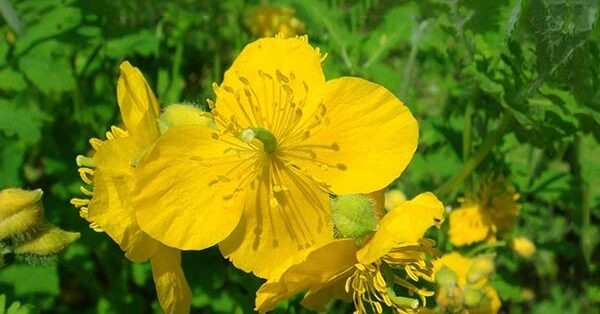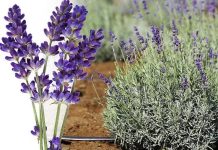Nature holds countless secrets—some of which are far more powerful than even the most advanced pharmaceutical products. One of these natural wonders is “Christ’s Blood”, also known by its scientific name, Chelidonium majus. In Georgian folk medicine, it’s called “Kristes Siskhla”, which translates literally to Christ’s Blood—a name that reflects both its deep red sap and its revered healing power.

This remarkable plant has been used since ancient times for its wide range of medicinal properties. What makes it especially unique is its innate ability to “find” the source of illness, going beyond just treating symptoms. It is said that Christ’s Blood doesn’t just heal—it detects what needs healing.
Let’s explore how this plant is used, what conditions it can treat, and why it may be far more effective than many expensive pharmaceutical products.
What is Christ’s Blood (Chelidonium majus)?
Christ’s Blood is a wild herbaceous plant that grows in temperate climates and can often be found in forests, gardens, and near homes. Its most distinguishing feature is the bright orange-red sap that flows when its stem is broken. This sap is where most of the medicinal power lies, and it has been used for centuries to treat various diseases, both internally and externally.
Christ’s Blood can be used in many forms:
Fresh juice
Decoctions (boiled plant extracts)
Tinctures (alcohol-based infusions)
Extracts (concentrated liquids)
A Natural Healer for Eye Diseases
In traditional medicine, Christ’s Blood is especially valued for its effectiveness in treating eye conditions. To prepare a remedy, mix the fresh juice of the plant with honey in a 1:1 ratio, then heat it gently on low heat until the foaming stops and it reaches a thicker, honey-like consistency.
This preparation is not placed directly into the eyes but is applied externally to the painful or inflamed area around the eyes. The combination of antimicrobial and anti-inflammatory properties makes this treatment particularly soothing and effective.
Skin Conditions – From Eczema to Warts
In rural areas, Christ’s Blood has long been used for bathing children with scrofula, a form of tuberculosis that affects the lymph nodes. The decoction made from boiling the plant is believed to draw out toxins, soothe the skin, and promote healing.
It has also been used to treat skin tuberculosis, reduce scabies, heal warts, and even minimize wrinkles. The raw, fresh juice of the plant can be applied directly to skin growths like:
Warts
Papillomas
Polyps
Condylomas
The juice works by burning off the unwanted tissue naturally, without surgery or expensive creams. Its antiviral and antifungal properties help disinfect the area and prevent recurrence.
Internal Use – Digestive and Liver Health
Christ’s Blood is not only for external use. When used internally in very small doses, it supports liver and gallbladder function, and can be effective against:
Gallbladder disorders
Liver stagnation
Digestive issues
Polyps in the rectum
Parodontosis (gum disease)
Dosage is key here: the juice is highly potent and even mildly toxic in large amounts. Traditionally, 5–7 drops of juice are diluted in 50–60 ml of water and taken before bedtime. This must be done under supervision or based on trusted recipes.
Preserving the Juice for Winter Use
The plant’s healing powers aren’t limited to the summer months. You can preserve the juice for year-round use by harvesting 12–15 cm long stems with flowers, grinding them with a meat grinder, and pressing out the juice.
For preservation:
Add 500 grams of vodka or 250 grams of pure alcohol to 1 liter of juice.
Store in a dark glass bottle, in a cool place.
This preserved tincture can be used internally (in drops) or externally, depending on the ailment.
Treatment for Stomach Issues
For stomach-related problems, Christ’s Blood can be consumed (again, in very small doses) to stimulate digestion, reduce inflammation, and combat infections in the GI tract. Traditional dosage is 1 teaspoon of juice, taken three times a day before meals—but this depends greatly on individual tolerance and must be approached cautiously.
⚠️ Important Warning: Christ’s Blood Is a Toxic Plant!
Yes, Christ’s Blood is a medicinal herb, but it’s also poisonous if misused. The active compounds—while healing in small amounts—can be toxic in large doses. Therefore, you should always:
Start with just 2–3 drops
Avoid self-medication without research or guidance
Never exceed the recommended dosage
Consult a healthcare professional before internal use, especially if you are pregnant, nursing, or on other medications
More Than Just a Medicine: A Lifestyle Philosophy
At kop.ge, we believe that natural remedies like Christ’s Blood offer more than just healing—they offer a chance to reconnect with our roots, reduce our dependency on synthetic drugs, and take control of our health in simple, affordable ways.
Christ’s Blood is just one of many herbs that our ancestors used effectively—long before pharmacies existed. These treatments:
Cost virtually nothing
Are easy to prepare at home
Offer holistic, long-term healing
Avoid the side effects common in pharmaceutical products
And just as importantly, they can turn everyday people into knowledgeable, self-sufficient caretakers of their own health.
Natural Healing Is for Everyone
Many of the remedies we share at kop.ge can easily become part of your daily wellness routine. These are not obscure, hard-to-find plants. Christ’s Blood, for example, may already be growing in your garden or a nearby field.
With time, you’ll gain the confidence to share these remedies with family and friends—spreading wellness and saving money. You’ll realize that being healthy, beautiful, and resourceful doesn’t require luxury products or medical bills. Sometimes, it only takes what’s already in your backyard.
Final Note
All content and recipes shared on kop.ge are intended to support your health naturally. However, even natural remedies can carry risks if misused. We always recommend consulting a healthcare provider before beginning any new treatment, especially with potent herbs like Chelidonium majus.
Let nature be your guide—but let wisdom be your compass.












